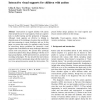Free Online Productivity Tools
i2Speak
i2Symbol
i2OCR
iTex2Img
iWeb2Print
iWeb2Shot
i2Type
iPdf2Split
iPdf2Merge
i2Bopomofo
i2Arabic
i2Style
i2Image
i2PDF
iLatex2Rtf
Sci2ools
PUC
2010
2010
Interactive visual supports for children with autism
Interventions to support children with autism often include the use of visual supports, which are cognitive tools to enable learning and the production of language. Although visual supports are effective in helping to diminish many of the challenges of autism, they are difficult and time-consuming to create, distribute, and use. In this paper, we present the results of a qualitative study focused on uncovering design guidelines for interactive visual supports that would address the many challenges inherent to current tools and practices. We present three prototype systems that address these design challenges with the use of large group displays, mobile personal devices, and personal recording technologies. We also describe the interventions associated with these prototypes along with the results from two focus group discussions around the interventions. We present further design guidance for visual supports and discuss tensions inherent to their design. Keywords Visual supports
Autism | Design | PUC 2010 | Visual Supports |
| Added | 20 May 2011 |
| Updated | 20 May 2011 |
| Type | Journal |
| Year | 2010 |
| Where | PUC |
| Authors | Gillian R. Hayes, Sen H. Hirano, Gabriela Marcu, Mohamad Monibi, David H. Nguyen, Michael T. Yeganyan |
Comments (0)

